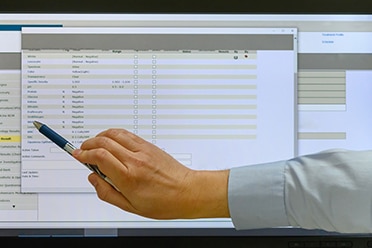March 15, 2023
How IT Enables Providers to Optimize Care
Effective deployment of technology helps healthcare organizations overcome challenges and improve patient outcomes.
IN THIS ARTICLE
The Challenges Facing
Healthcare IT
Technology Solutions and Services to Optimize Care
Key Outcomes from Using Technology to Optimize Care
How Technology Is Driving the Evolution of Healthcare
From the bedside to the boardroom, technology continues to transform the way healthcare organizations deliver care and manage operations. In one survey, 97 percent of healthcare executives said that continuous advances in technology are a reliable driver of long-term organizational strategy — even more than economic, political or social trends.
In recent years, healthcare organizations have widely adopted cloud solutions and Software as a Service (SaaS) applications. Cloud scalability, reliability and ease of management help organizations alleviate IT staffing challenges, increase agility and pursue advanced capabilities such as artificial intelligence. Shifting technology resources away from on-premises data centers allows IT teams to focus on systems and workflows that enhance care, improve the clinician experience and address staffing needs.
Distributed care delivery, with its attendant effects on the flow and availability of data, has also created significant changes in IT and overall operations. The expansion of data sources has added complexity to data security and data governance. In response, many organizations are revising their approach to identity and access management, relying on automation tools to increase visibility and control over patient and business data. Within this evolving, complex ecosystem, they must be able to verify and validate identity while limiting access as much as possible.
Healthcare organizations recognize the immense value of data, but many struggle to mature their data analytics capabilities so they can use their data assets in a meaningful way. Expert partners can be a valuable resource as organizations modernize their ability to gather, source and integrate data. Those that use data effectively can derive multiple benefits, including faster, higher-quality decision-making that improves patient outcomes and increases business resilience.
As healthcare organizations proceed with their digital transformation journeys, the next phase of maturity is optimization: adapting the IT investments they have made to ensure they support desired outcomes as effectively as possible.

DATA
By introducing new data sources, the provision of care anywhere heightens the focus on security; increases the need for stronger identity and access management; and creates opportunities in analytics, automation and AI.

OPTIMIZATION
Organizations are moving from disparate, best-of-breed tools, which often present integration challenges, to integrated platforms and application programming interfaces to maximize value at every step of the clinical workflow.

RESILIENCE
Data security is inseparable from business resilience. Healthcare organizations should have cloud security strategies, incident response plans and backup and recovery systems hardened against ransomware-specific vulnerabilities.
The Challenges Facing Healthcare IT
IT solutions empower organizations to solve problems and pursue new opportunities. At the same time, technology may introduce risks, transform workflows and add complexity. Many organizations lack the ability to manage these cycles effectively, which prevents them from generating and acting on data-driven insights that would propel them forward.
MODERNIZE SECURITY PROGRAMS
Ransomware is here to stay, and healthcare remains a target. Maintaining momentum and achieving maturity in a cybersecurity program are difficult when organizations struggle to attract and retain CISOs. Providers have made significant investments in security solutions, but gaps persist in cloud and data security, especially for sensitive data.
SIMPLIFY SECURITY STACKS
As organizations face increased IT complexity, zero trust can help reduce security stacks to a more manageable level. Faced with the need to monitor and optimize disparate security systems, healthcare providers may turn to integrated solutions or augment internal resources and expertise with virtual CISOs or managed services.
INCREASE DATA VISIBILITY
The risks of a cyberattack increase when organizations lack visibility and control over data. Many organizations overestimate the resilience of their backups, a costly mistake that can affect patient care and increase operational downtime and financial cost. Incident response plans are essential to prepare for the impact of an attack, especially ransomware.
REDUCE BURDEN ON IT STAFF
Staffing shortages affect healthcare organizations in almost every area, including IT, clinical care and patient engagement. Automation can be a powerful solution to this challenge, especially in the IT department, by handling rote tasks, facilitating security monitoring and processes, and supporting IT service management through platforms such as ServiceNow.
BUILD A COHESIVE STRATEGY
Optimizing IT is a common challenge for healthcare organizations. For example, mobile devices can improve the clinician experience, but only if process and clinical workflow considerations are taken into account. And while data analytics has great value, there are hurdles to becoming data-driven, including legacy data center solutions, lack of visibility and poor systems integration.
Develop a cohesive strategy for your unified communication and collaboration solutions.
From Challenge to Opportunity
2022
The worst financial year for hospitals since the start of the pandemic, with approximately half of U.S. hospitals reporting a negative margin
Source: Kaufman Hall, "National Hospital Flash Report," January 2023
600+
The estimated number of rural U.S. hospitals (nearly 30 percent of all rural hospitals in the country) at risk of closing because of financial losses and insufficient reserves
Source: Center for Healthcare Quality and Payment Reform, "Rural Hospitals at Risk of Closing," October 2022
21%
The percentage of clinicians who changed employers in the past two years
Source: advisory.com, "Five Insights from Advisory Board’s 2022 Clinician Survey," Nov. 28, 2022
69%
The percentage of clinicians who say they are overwhelmed by the volume of patient data
Source: elsevier.com, "Clinician of the Future: Report 2022," March 2022
56%
The percentage of clinicians who predict that within 10 years, they will make most of their clinical decisions using AI-supported tools
Source: elsevier.com, "Clinician of the Future: Report 2022," March 2022
57%
The percentage of healthcare executives who believe AI will have a transformational, positive impact on their organization
Source: Accenture, "Digital Health Technology Vision 2022," June 2022
Technology Solutions and Services to Optimize Care
Much of the work for healthcare now revolves around the need to build, secure and implement a modern data ecosystem. The ability to gather data from multiple sources — ranging from medical devices to out-of-state providers — and transform it into actionable information is the ultimate goal. This requires a sustained commitment to a well-planned data strategy. The right solutions are essential to bring cohesion and efficiency to an area that is continuously becoming more complex.
Organizations that have invested in digital transformation can take the next step toward optimization by identifying weaknesses in IT integration and interoperability, which can hamper automation, analytics and AI. Many healthcare organizations have made advances in digital workflows. They can build on that progress by reducing siloed solutions in favor of modern data platforms that integrate data and yield insights that improve workflows (and, thereby, patient outcomes) even further. Unified communication and collaboration tools provide similar benefits of clinician satisfaction and patient engagement. Notably, these solutions help organizations overcome staffing constraints.
The modern data platform serves as a foundation to optimize improvements in patient care, IT strategy and business outcomes.

MODERN DATA PLATFORMS
Modern data platforms help organizations govern, modernize, manage and optimize their data and analytics ecosystems for better business insights. The advantages of a modern platform include using a single source of data to support many workloads, reducing siloes and facilitating data access controls. SaaS-based solutions reduce the management associated with on-premises data centers, which enables IT leaders to prioritize data queries and insights over system maintenance.
SaaS is easier to scale and provides flexibility to financial resources. Rather than purchasing and maintaining hardware, organizations can shift resources as opportunities allow and circumstances change. During the pandemic, for example, providers that were predominantly cloud-based found it much easier to adapt to remote work and roll out solutions such as telehealth tools.

DATA INSIGHTS
Data platforms also provide a foundation to pursue true optimization opportunities such as advanced analytics, automation and AI. In day-to-day workflows, these solutions can significantly reduce staffing-related pain points. But their real power lies in their ability to deliver data and insights that help organizations adapt, improve and make decisions. Data reporting and dashboards, automated business insights, machine learning and self-service portals deliver a steady flow of information that drives predictive and prescriptive strategy.
A partner with expertise in data analytics can help an organization develop a data maturity program mapped to its unique goals. Such services might include recommendations related to data platform management, assessments and roadmaps, health checks and ongoing optimization support.

PATIENT ENGAGEMENT
Contact centers and patient portals are crucial points of engagement and should be modernized accordingly. They also deliver a better user experience for patients; for example, one system used contact center AI to automate its entire call intake process for COVID-19 vaccination scheduling. Unified communication and collaboration tools empower clinicians, administrators and care professionals to deliver better outcomes. Patient engagement and, more broadly, communication are essential for effective incident response and business resilience plans. The ability to integrate call center technology (including AI) and voice platforms with incident management is critical. For example, providers may need to scale up contact center services quickly, customize messages with timely scripts and prompts, and orchestrate communication across multiple locations.
The Importance of Speed to Value
Modern data platforms facilitate new ways of managing, integrating and acting on data. Cloud adoption, particularly for electronic health record and financial systems, is an important step toward implementing a modern data platform. In turn, such a platform can be a driver for increased cloud adoption. The capabilities of existing EHRs are another good starting point to evaluate complementary data platform investments.
HARNESS THE CLOUD
Organizations that replace legacy solutions with SaaS-based tools and multicloud environments gain the agility and flexibility to move faster when it comes to data processing and analytics.
GENERATE IMPACT
Teams with greater data maturity are able to connect data to the clinical or business process where it can provide the most impact, potentially by automating processes, improving integration or reducing friction.
ACCELERATE VALUE
Reducing the time needed to measure results speeds up the process of developing useful insights and applying them quickly and efficiently, which supports ongoing iteration.
SPEED DECISION-MAKING
The ability to make data-driven decisions faster is essential for organizations seeking to evaluate past performance, identify areas for improvement and plot a course to get there.
Key Outcomes from Using Technology to Optimize Care
By focusing on key outcomes that improve healthcare, organizations can more effectively target their initiatives to better serve all patients.
EXPLAINING THE QUINTUPLE AIM
The Institute for Healthcare Improvement established its Triple Aim in 2007 as a framework to help healthcare organizations improve their performance. In recent years, a Quintuple Aim has emerged to reflect new challenges in healthcare. The Quintuple Aim seeks to:
- Improve population health
- Enhance the care experience
- Reduce costs
- Address burnout in the workforce
- Reduce inequities in health and healthcare
Organizations must be able to map IT investments to Quintuple Aim objectives. For example, beginning in 2023, Blue Cross Blue Shield of Massachusetts will tie payments to health equity performance, which means providers must be able to measure related metrics.
Within this scope, technology can also drive custom solutions. For example, one healthcare system designed automated tools to take over the manual tasks that were most disliked or identified as most in need of transformation.
DRIVE IMPROVEMENT WITH DATA
Data analytics can be a valuable source of insight across financial, business and patient spheres. Better data — holistic, accessible, visible and secure — helps organizations make strategic decisions that increase business resilience and improve care by establishing efficient workflows. Organizations should continually iterate these advances through ongoing measurement and reporting.
A good data program, supported by a modern data management platform, can also help organizations use human resources most efficiently — a key factor in retaining healthcare professionals. For example, one survey found that schedule flexibility is important to clinicians, but various roles and groups define that differently. Data analytics could help providers understand optimal levels for clinical and operational workloads and align these to employees’ preferences.
ADDRESS IT SKILL GAPS
Workload challenges and cloud adoption make managed services a flexible and often cost-effective resource. One organization might leverage configuration services to make new hardware network-ready. Another might want to offload day-to-day monitoring of contact center solutions. A third-party managed services partner can help identify the service level that meets an organization’s needs and budget.
Story by Mike Larsen, Lee Pierce, Matt Sickles, Tom Stafford, Eli Tarlow


